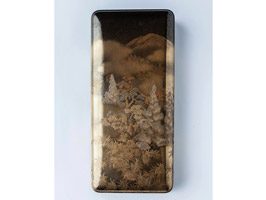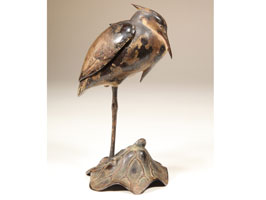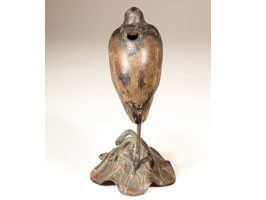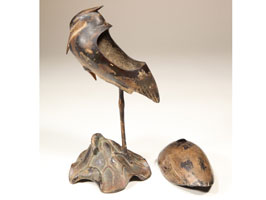Lacquer's Recent Entry
At first I was attracted by the design of a crow. And then I noticed that the rising sun can be seen different color by several angles. Color of the gold and fine Makie work of crow are not usual level and all is of fine quality. It is simple, but is the good work which is attracted whenever I look.
13.5cm-10.5cm-5.5cm(h) circa1850(End of Edo~Meiji era)
It is an amazing work to reproduce a ceramic work by the 16th century artist Hon'Ami Koetsu. Take it in your hands and it has the texture of Raku, but no weight! You realise that your eye has deceived your head, and you are holding a piece of lacquer ware. Our professional camera man didn't notice it is lacquer work. He believed it is old ceramic work until end photographing. Mr.Wakamiya strives to rediscover many 'lost' lacquer techniques, particularly in the imitation of diverse materials such as ceramic, wood and metal.
size 12cm-11.5cm-9cm(h) with original signed box.
It is an excellent piece impressed by the dynamic design of a lily. I think that the size of this work is also large and it is his time-consuming masterpiece very much.
Stationery box with a design of lily and dragonfly, of carved Navy,Black,Beige,Yellow,Red and Green. lacquer over a wood base. With the original signed box, inscribed on the exterior of the lid: Carved Lacquer lily design stationery Box; And signed: Yosai (Yamashita Yosai, born 1902).
Yamashita Yosai worked in Takamatsu on Shikoku,and exhibited widely at the Teiten and Bunten art exhibitions. After the War he continued to show at the Nitten, as well as the Nihon Dento Kogeiten.
size 39-32-10(h)cm
SOLD
Kōbon or incense tray in a square form. Ornamented with a design of a peacock. Of red,orange,navy blue and beige layered lacquers, carved in chōshitsu technique. With original signed box,
Otomaru Kōdō was born in Takamatsu and began studying chūshitsu or carved-lacquer in 1915. In 1932, he first exhibited at the Imperial Art Exhibitions with the 13th Teiten, afterwards continuing to exhibit regularly at the Teiten, the Shin-Bunten and, after the Pacific War, at the Nitten. In 1955, he was designated Jūyō Mukei Bunkazai or Important Intangible Cultural Asset (commonly referred to as Ningen Kokuhō or Living National Treasure) for the chūshitsu technique. His work is in the collections of many museums in Japan, including the Tokyo National Museum of Modern Art.
A great design and beautiful example of Otomaru Kōdō's early, pre-war work.
This incense container in the shape of a puppy is made of lacquer on wood. And it faithfully represents a puppy; even its paws are depicted on the bottom as seen in Netsuke (seal caddy accessory) holding the same form.
The one (old Cazale collection) similar to this work is owned to Osaka Municipal Museum of Art now.
size 5×7×8.5(h)cm
Sold

























































